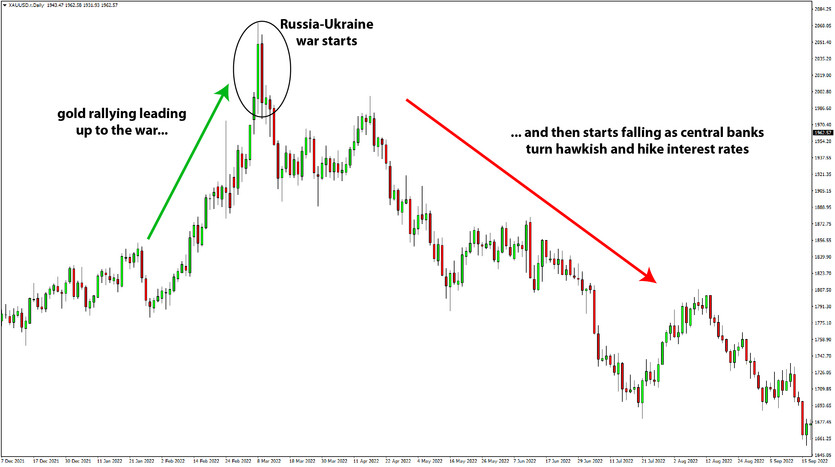The valuation of gold is influenced by a myriad of factors including demand and supply dynamics, interest rate shifts, and investor risk perception. This may seem straightforward, but the interaction of these elements often leads to unexpected outcomes. Despite a widespread belief that gold acts as a reliable hedge against inflation, this assumption is largely misplaced.
While the notion that the worth of paper currency dwindles as more is printed - in contrast to the stable supply of gold - appears reasonable, it doesn't accurately represent the relationship between gold and inflation. Gold's price movements in the short term are better predicted by fluctuations in interest rates and overall market volatility.
Critical Gold Price Determinants
The pivotal determinants of gold prices are supply and demand dynamics, interest rates, and investor attitudes. The misconception of utilizing gold as an inflation shield is rooted in the belief that its appreciation can counterbalance inflationary forces.
Gold's price movement is also subjected to investor sentiment about risk, although this relationship can be erratic. During a broad commodity sell-off driven by heightened risk aversion, gold may depreciate alongside other commodities.
Owning gold doesn't yield any interest income. On the contrary, it incurs costs such as storage and insurance. Given gold's tendency for unpredictable price swings and its intricate relationship with other assets, it is advisable to limit gold's representation to no more than 10% of any portfolio.
Gold's Inconsistent Correlation with Inflation
Claude B. Erb, an economist at the National Bureau of Economic Research, and Campbell Harvey, a professor at Duke University's Fuqua School of Business, have scrutinized gold's price in relation to several variables. Surprisingly, their studies revealed a weak correlation between gold and inflation.
When inflation escalates, it doesn't necessarily indicate that gold is a wise investment. For instance, in 2022, gold prices dropped, despite a concurrent inflation rate of around 7%.
Gold: A Risk-On/Risk-Off Asset
In the global financial markets, gold often functions as a 'risk-on/risk-off' asset. This means that it can behave differently depending on the prevailing market sentiment. In times of economic prosperity and stability, where there's a 'risk-on' sentiment, investors might turn away from gold to seek potentially higher returns in riskier assets. However, when markets are turbulent and there's a 'risk-off' sentiment, gold can become more attractive due to its reputation as a safe haven asset.
Yet, it's important to note that this is not always the case. During periods of intense market panic, gold may also be subject to sell-offs as investors scramble to convert their assets to cash or cash-equivalents. Thus, the performance of gold during times of market stress can be somewhat of a double-edged sword, reflecting both its safe haven status and its susceptibility to market panic.

Supply Factors and Gold
In comparison to other commodities, the supply of gold is unique due to its non-consumable nature. Nearly all the gold ever mined still exists in a usable form. This is unlike commodities such as oil or coffee, which are consumed and thus have a continuously renewing demand.
This might suggest that the price of gold should drop as its supply increases. However, this is not the case due to a few key factors. Firstly, the demand for gold, particularly in the form of jewelry and as a store of value, continues to grow. This demand often comes from countries like India and China, where gold has a cultural significance beyond its financial value. Moreover, gold that is used in jewelry or stored as a form of wealth is effectively 'removed' from the market for a long period of time, which helps maintain its price.
The Role of Interest Rates
The influence of interest rates on gold prices is considerable and generally inverse. During periods of low-interest rates, gold often thrives as an attractive investment. When the Federal Reserve responded to the COVID pandemic with rate cuts in early 2020, gold prices saw a significant increase.
Conversely, when interest rates climb, gold's appeal may decrease as it does not offer interest income. Therefore, rising interest rates can make interest-bearing securities more attractive relative to gold. This was evident in 2022, when gold prices started to fall as the Federal Reserve began to hike interest rates to manage high inflation.
Central Banks and Gold
Central banks also significantly influence gold prices. When economies are thriving, and foreign exchange reserves are substantial, central banks may opt to decrease their gold holdings as gold does not generate any return.
However, selling gold can pose a dilemma for central banks, as other investors are usually less interested in gold during economic prosperity, potentially leading to a decrease in its price. To prevent disrupting the gold market excessively, central banks have adopted a quasi-collaborative approach, as per the Washington Agreement, which caps their combined gold sales at 400 metric tons per year.
Exchange-Traded Funds: An Alternate Route to Gold Investment
Exchange-Traded Funds (ETFs) have significantly transformed the landscape of gold investments. ETFs such as SPDR Gold Shares (GLD) and iShares Gold Trust (IAU) have emerged as major players in the gold market, providing a bridge for ordinary investors to participate in the gold market without directly dealing with the physical metal or mining stocks.
These gold-backed ETFs hold physical gold as their underlying asset and trade on the stock exchange, just like individual stocks. This means that investors can buy and sell shares in these ETFs, effectively gaining exposure to the price movements of gold, without the inconvenience of storing and insuring physical gold. Furthermore, these ETFs are designed to reflect the price of gold rather than to influence it, providing a more transparent and accessible investment vehicle for investors who want exposure to gold in their portfolio.
However, it's crucial to remember that while investing in gold ETFs does provide a convenient way to gain exposure to gold price movements, it also carries risks. These include the potential for the ETF’s market price to deviate from the net asset value, operational risks of the fund, and, of course, the inherent volatility of gold prices themselves.
Incorporating Gold into Your Investment Portfolio
Gold's unique characteristics make it a valuable component in an investor's portfolio. Its role as a potential hedge against market volatility and as a store of value during times of economic uncertainty can help diversify an investment portfolio. However, given gold's unpredictable price movements and its sometimes counterintuitive behavior, it's important to approach gold investment with caution.
As an asset class, gold should be treated as part of the commodities allocation in an investor's portfolio. However, it is not recommended to overly concentrate on gold or any single asset. According to conventional wisdom and prudent risk management, gold holdings should form a minor portion, around 5% to 10%, of a diversified investment portfolio.
It's also worth noting that gold is less about short-term gains and more about long-term preservation of purchasing power. While it's true that gold prices can surge in times of economic uncertainty, they can also decline or stagnate for long periods. The purpose of holding gold in a portfolio is less about making a profit and more about providing a safety net, an insurance of sorts, against unforeseen market downturns.
In summary, while gold can add a layer of diversification and serve as a potential hedge against risk in a portfolio, its allocation should be carefully considered based on the individual's risk tolerance, investment horizon, and overall investment goals.





